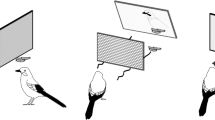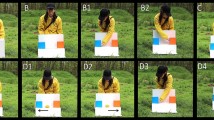Abstract
It is well known that humans represent the mental states of others and use these representations to successfully predict, understand, and manipulate their behaviour. This is an impressive ability. Many comparative psychologists believe that some non-human apes and monkeys attribute mental states to others. But is this ability unique to mammals? In this paper, I review findings from a range of behavioural studies on corvids, including food caching, food recaching and food sharing studies. In order to protect their caches from being pilfered, corvids successfully keep track of observing conspecifics, employ a number of caching and recaching strategies, and exploit environmental factors to reduce the amount of visual and auditory information available to observing conspecifics. When giving food items as gifts, corvids give items for which conspecifics have developed a preference. I argue that the available evidence supports the hypothesis that corvids attribute mental states to conspecifics. I further hypothesize that corvids do so through process-driven simulation and the running of non-verbal multimodal rules accomplished by a class of mental representations called semantic pointers.
Similar content being viewed by others
References
Balleine B, Dickinson A (1998) The role of incentive learning in instrumental outcome revaluation by sensory-specific satiety. Anim Learn Behav 26(1):46–59
Blouw P, Solodkin E, Thagard P, Eliasmith C (2015) Concepts as semantic pointers: a framework and computational model. Cogn Sci. doi:10.1111/cogs.12265
Bugnyar T (2007) An integrative approach to the study of ‘theory-of-mind’-like abilities in Ravens. Jpn J Anim Psychol 57(1):15–27
Bugnyar T (2010) Knower–guesser differentiation in ravens: others’ viewpoints matter. Proc Royal Soc Lond B Biol Sci. doi:10.1098/rspb.2010.1514
Bugnyar T (2013) Social cognition in ravens. Comp Cogn Behav Rev 8:1–12
Bugnyar T, Heinrich B (2005) Ravens, Corvus corax, differentiate between knowledgeable and ignorant competitors. Proc R Soc Lond B Biol Sci 272(1573):1641–1646
Bugnyar T, Heinrich B (2006) Pilfering ravens, Corvus corax, adjust their behaviour to social context and identity of competitors. Anim Cogn 9(4):369–376
Bugnyar T, Kotrschal K (2002) Observational learning and the raiding of food caches in ravens, Corvus corax: is it ‘tactical’deception? Anim Behav 64(2):185–195
Bugnyar T, Kotrschal K (2004) Leading a conspecific away from food in ravens (Corvus corax)? Anim Cogn 7(2):69–76
Call J, Tomasello M (2008) Does the chimpanzee have a theory of mind? 30 years later. Trends Cogn Sci 12(5):187–192
Camp E (2009) A language of baboon thought? In: Lurz R (ed) Philosophy of animal minds. Cambridge University Press, New York, pp 108–127
Clary D, Kelly D (2011) Cache protection strategies of a non-social food-caching corvid, Clark’s nutcracker (Nucifraga columbiana). Anim Cogn 14(5):735–744
Clayton N, Emery N (2007) The social life of corvids. Curr Biol 17(16):R652–R656
Clayton N, Griffiths D, Emery N, Dickinson A (2001) Elements of episodic-like memory in animals. Philos Trans R Soc Lond 356:1–9
Clayton N, Dally J, Emery N (2007) Social cognition by food-caching corvids. The western scrub-jay as a natural psychologist. Philos Trans R Soc Lond B Biol Sci 362(1480):507–522
Correia S, Dickinson A, Clayton N (2007) Western scrub-jays anticipate future needs independently of their current motivational state. Curr Biol 17(10):856–861
Dally J, Emery N, Clayton N (2004) Cache protection strategies by western scrub-jays (Aphelocoma californica): hiding food in the shade. Proc Biol Sci 271:S387–S390
Dally J, Emery N, Clayton N (2005a) Cache protection strategies by western scrub-jays, aphelocoma californica: implications for social cognition. Anim Behav 70(6):1251–1263
Dally J, Emery N, Clayton N (2005b) The social suppression of caching in western scrub-jays (aphelocoma californica). Behaviour 142(7):961–977
Dally J, Emery N, Clayton N (2006) Food-caching western scrub-jays keep track of who was watching when. Science 312(5780):1662–1665
Davidson D (1982) Rational animals. Dialectica 36(4):317–327
Dickinson A, Balleine B (1995) Motivational control of instrumental action. Clin Psychol Sci 4:162–167
Dugas-Ford J, Rowell J, Ragsdale C (2012) Cell-type homologies and the origins of the neocortex. Proc Natl Acad Sci USA 109(42):16974–16979
Dunbar R (1998) The social brain hypothesis. Evol Anthropol 6(5):178–190
Eliasmith C (2013) How to build a brain: a neural architecture for biological cognition. Oxford University Press, Oxford
Eliasmith C, Stewart T, Choo X, Bekolay T, DeWolf T, Tang Y, Rasmussen D (2012) A large-scale model of the functioning brain. Science 338(6111):1202–1205
Emery N (2006) Cognitive ornithology: the evolution of avian intelligence. Philos Trans R Soc Lond B Biol Sci 361(1465):23–43
Emery N, Clayton N (2001) Effects of experience and social context on prospective caching strategies by scrub jays. Nature 414:443–446
Emery N, Clayton N (2004) Comparing the complex cognition of birds and primates. In: Kaplan G, Rogers L (eds) Comparative vertebrate cognition. Springer, US, pp 3–55
Goldman A (2006) Simulating minds: the philosophy, psychology, and neuroscience of mindreading. Oxford University Press, Oxford
Heinrich B (1999) Mind of the raven: investigations and adventures with wolf-birds. Cliff Street Books, New York
Hochner B (2008) Octopuses. Curr Biol 18(19):R897–R898
Ikeda Y (2009) A perspective on the study of cognition and sociality of cephalopod mollusks, a group of intelligent marine invertebrates. Jpn Psychol Res 51(3):146–153
Kaminski J, Call J, Tomasello M (2008) Chimpanzees know what others know, but not what they believe. Cognition 109(2):224–234
Legg E, Clayton N (2014) Eurasian jays (Garrulus glandarius) conceal caches from onlookers. Anim Cogn 17:1223–1226
Lurz R (2011) Mindreading animals: the debate over what animals know about other minds. MIT Press, Cambridge
Marticorena D, Ruiz A, Mukerji C, Goddu A, Santos L (2011) Monkeys represent others’ knowledge but not their beliefs. Dev Sci 14(6):1406–1416
Martin A, Santos L (2014) The origins of belief representation: monkeys fail to automatically represent others’ beliefs. Cognition 130(3):300–308
Mather J (2008) Cephalopod consciousness: behavioural evidence. Conscious Cogn 17(1):37–48
Nichols S, Stich S (2003) Mindreading: an integrated account of pretence, self-awareness, and understanding other minds. Clarendon, Oxford
Ostojić L, Shaw RC, Cheke LG, Clayton NS (2013) Evidence suggesting that desire-state attribution may govern food sharing in Eurasian jays. Proc Natl Acad Sci USA 110:4123–4128
Ostojić L, Legg EW, Shaw RC, Cheke LG, Mendl M, Clayton NS (2014) Can male Eurasian jays disengage from their own current desire to feed the female what she wants? Biol Lett. doi:10.1098/rsbl.2014.0042
Penn D, Povinelli D (2007) On the lack of evidence that non-human animals possess anything remotely resembling a ‘theory of mind’. Philos Trans R Soc B 362:731–744
Premack D, Woodruff G (1978) Does the Chimpanzee Have a Theory of Mind? Behav Brain Sci 1:515–526
Shaw R, Clayton N (2012) Eurasian jays, Garrulus glandarius, flexibly switch caching and pilfering tactics in response to social context. Anim Behav 84(5):1191–1200
Shaw R, Clayton N (2013) Careful cachers and prying pilferers: Eurasian jays (Garrulus glandarius) limit auditory information available to competitors. Proc R Soc B Biol Sci 280:20122238
Shaw R, Clayton N (2014) Pilfering Eurasian jays use visual and acoustic information to locate caches. Anim Cogn 17:1281–1288
Stulp G, Emery N, Verhulst S, Clayton N (2009) Western scrub-jays conceal auditory information when competitors can hear but cannot see. Biol Lett 5:583–585
Taylor A, Miller R, Gray R (2012) New Caledonian crows reason about hidden causal agents. Proc Natl Acad Sci U S A 109(40):16389–16391
Thagard P (2015) Mind-society: from brains to social sciences and professions, draft 2. University of Waterloo, Waterloo
Thom J, Clayton N (2013) Re-caching by Western scrub-jays (Aphelocoma californica) cannot be attributed to stress. PLoS One 8(1):e52936. doi:10.1371/journal.pone.0052936
Tomasello M, Call J, Hare B (2003) Chimpanzees understand psychological states–the question is which ones and to what extent. Trends Cogn Sci 7(4):153–156
Van der Vaart E, Verbrugge R, Hemelrijk C (2012) Corvid re-caching without ‘theory of mind’: a model. PLoS ONE. doi:10.1371/journal.pone.0032904
Vander Wall S (1990) Food hoarding in animals. University of Chicago Press, Chicago
Wobber V, Herrmann E, Hare B, Wrangham R, Tomasello M (2014) Differences in the early cognitive development of children and great apes. Dev Psychobiol 56(3):547–573
Acknowledgments
Thank you to Paul Thagard, John Turri, Chris Eliasmith, Paul Meyer and anonymous reviewers for helpful feedback. This research was supported by the Social Sciences and Humanities Research Council of Canada.
Author information
Authors and Affiliations
Corresponding author
Rights and permissions
About this article
Cite this article
Keefner, A. Corvids infer the mental states of conspecifics. Biol Philos 31, 267–281 (2016). https://doi.org/10.1007/s10539-015-9509-8
Received:
Accepted:
Published:
Issue Date:
DOI: https://doi.org/10.1007/s10539-015-9509-8




